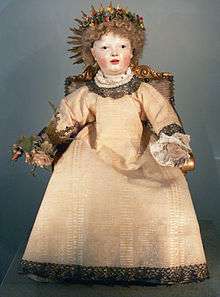Christkind

The Christkind (German "Christ-child", pronounced [ˈkʁɪstkɪnt]) is the traditional Christmas gift-bringer in Austria, Switzerland, Germany (in the south and west), the Czech Republic, Slovenia, Croatia, Italy (however only the South Tirol area), Liechtenstein, Luxembourg, Portugal, Slovakia, Hungary, parts of northeastern France, Upper Silesia in Poland, parts of Hispanic America, in certain areas of southern Brazil and in the Acadiana region of Louisiana. In Italian, it is called Gesù Bambino, in Portuguese Menino Jesus ("Jesus Boy"), in Hungarian Jézuska ("Little Jesus"), in Slovak Ježiško ("Little Jesus"), in Czech Ježíšek ("Little Jesus"), in Latin America "Niño Dios" ("God Child") or "Niño Jesús" ("Jesus Child") and in Croatian Isusić or Isusek ("Little Jesus").
Promulgated by Martin Luther at the Protestant Reformation in 16th–17th-century Europe, many Protestants adopted this gift bringer, the Christ Child or Christkindl, and the date of giving gifts changed from December 6 to Christmas Eve.[1] As such, the "Lutheran Church promoted Christ as the children's gift-giver, hoping to draw attention to the child for whom Christmas was named."[2] The Christkind was adopted in Catholic areas of Germany during the 19th century.[3] To this date, the Christkindl "remains the main gift bringer in many Catholic countries in Latin America."[4]

The Christkind is a sprite-like child, usually depicted with blond hair and angelic wings.[5] Martin Luther intended it to be a reference to the incarnation of Jesus as an infant (see Christ Child). Sometimes the Christ Child is, instead of the infant Jesus, interpreted as a specific angel bringing the presents, as it appears in some processions together with an image of little Jesus Christ. Later, the Christkind was said to make rounds delivering gifts with St. Nicholas.[6]
Children never see the Christkind in person, and parents tell them that Christkind will not come and bring presents if they are curious and try to spot it. The family enters the living room, where the Christmas tree has been put up, for the opening of presents (the Bescherung) when the parents say that they think that the Christkind who has brought the presents has now left again. In some traditions, the departure is announced by the ringing of a small bell, which the parents pretend to have heard or which is secretly done by one of the adults in the family.
Since the 1990s, the Christkind is facing increasing competition from the Weihnachtsmann in the American version of Santa Claus, caused by the use of Santa Claus as an advertising figure. Many traditionalist Catholics in recent times have advocated for the tradition of the Christkind as a "beautiful means of restoring the true meaning of Christmas".[7]
Christkindl or Christkindel are diminutive versions of Christkind. Christkind and Belsnickel are also found among communities of Volga German descent in Argentina. A well-known figure is the Christkind at the Christkindlesmarkt in Nuremberg, which is represented by a young woman chosen every year for this task.
Christkindl is also a part of the city of Steyr in Austria, named after the allegedly miraculous wax statue of Christkind in the town church.[8]
See also
- Kris Kringle (disambiguation), an Americanized pronunciation and spelling of Christkindl
- Christkindl Markt, a traditional holiday market in Austria, Germany and Eastern France
- Ježíšek, the same figure in the Czech tradition and Jézuska in Hungary
- Christ Child, Jesus as depicted in the Holy Family
- List of Christmas and winter gift-bringers by country
References
- ↑ Forbes, Bruce David, Christmas: a candid history, University of California Press, 2007, ISBN 0-520-25104-0, pp. 68-79.
- ↑ Siefker, Phyllis (1 January 1997). Santa Claus, Last of the Wild Men: The Origins and Evolution of Saint Nicholas, Spanning 50,000 Years. McFarland. p. 158. ISBN 9780786402465.
Beginning in the sixteenth century, the Lutheran Church promoted Christ as the children's gift-giver, hoping to draw attention to the child for whom Christmas was named.
- ↑ Perry, Joe (27 September 2010). Christmas in Germany: A Cultural History. Univ of North Carolina Press. p. 36. ISBN 9780807899410.
The Christkind, despite his Lutheran roots, was especially popular in Catholic households because of his lingering associations with Jesus.
- ↑ McCullough, Joseph (20 September 2014). The Story of Santa Claus. Bloomsbury Publishing. p. 43. ISBN 9781472803443.
Instead, the Christkind became popular in more Catholic countries, and remains the main gift bringer in many Catholic countries in Latin America.
- ↑ Clement A.Miles Christmas customs and traditions, their history and significance p. 230. Courier Dover Publications, 1976
- ↑ Forbes, Bruce David (1 October 2008). Christmas: A Candid History. University of California Press. ISBN 9780520258020.
...soon the Christ child was making the rounds with Saint Nicholas or a replacement figure.
- ↑ Matt, Michael J. "An Advent Reflection: Waiting for the Christ Child". The Remnant. Retrieved 12 December 2016.
- ↑ The history of Christkindl Retrieved 2009-12-20
External links
- Landler, Mark (12 December 2002). "Vienna Journal; For Austrians, Ho-Ho-Ho Is No Laughing Matter". The New York Times. Retrieved 10 December 2009.
- Cain, Phil (December 14, 2009). "Austria campaign to save Christkind from Santa Claus". BBC News. Retrieved December 14, 2009.